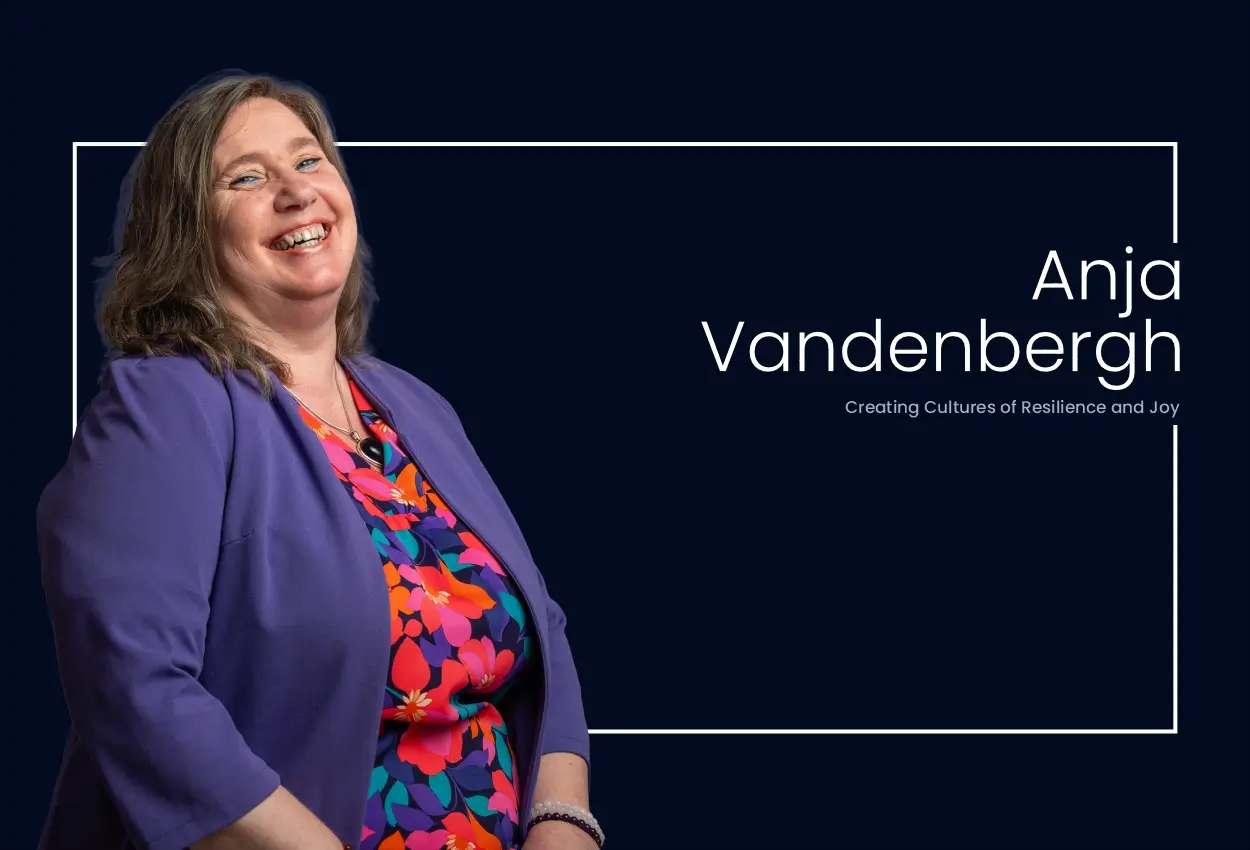Projects often begin with excitement and clear goals. Yet, as deadlines loom, tasks multiply, and the dreaded scope creeps, the weight of coordination can turn enthusiasm into exhaustion. Teams struggle to address shifting priorities, processes become tangled obstacles, and the original purpose gets buried by nitpicking. The pressure to deliver on time and within budget can then leave project managers feeling like jugglers with too many balls in the air, trying to maintain balance while everything around them seems to fall apart.
This is where Anja Vandenbergh brings a refreshing difference. As a project management consultant, coach, and trainer, she takes what feels overwhelming and makes it practical, clear, and even enjoyable. With her blend of structure and creativity, she transforms cluttered plans into simple roadmaps and equips project managers with tools that easily and drastically simplify success.
Discovering the World of Project Management
Anja’s journey into project management began in 1998 when she founded her own company, D’Aoni. She aimed then to provide IT application training in Word, Excel, and PowerPoint. She quickly realized the need to specialize in a tool less commonly mastered to help others save time: Microsoft Project. Driving herself to expertise through books, practice, and a strong curiosity, she soon attracted the attention of a well-known training center.
Anja enrolled in her first project management course at the Flemish Engineers Association in Antwerp to strengthen her knowledge, and despite not being an engineer, kept pace with the technical content. Her passion for learning carried her through additional courses and practical applications, blending her offer of project management tools with core methods. By 2006, she stepped into her first major role as a planning coordinator, marking the start of her path as a Project Management Consultant and expert.
Turning Processes into Pathways of Progress
For Anja, simplifying complex processes has always been both a necessity and a strength. As a planning coordinator, she noticed how multi-project environments could easily overwhelm teams unaccustomed to multiple priorities. Her solution was to break projects into smaller, manageable parts, easier to plan, assign, and budget.
Being a visual thinker, Anja relied heavily on visuals to make project details more digestible. Instead of lengthy manuals that would gather dust, she designed graphic one-pagers with strong keywords and clear step-by-step guides. This approach was also the result of personal experience: supporting her autistic child with visual communication methods such as “Give me the 5” (What, Why, When, Where, Who). By applying similar methods in project communication, she created clarity, structures that everyone could follow. As she often tells her students, “If you can explain the project to a six-year-old, then you truly understand it.”
The Silent Struggles of Implementation
Anja observes that while project managers are expected to ensure processes are followed, applying them effectively is rarely straightforward. The first hurdle is often resistance to change. Indeed, team members may see process changes as unnecessary disruptions to their routines.
Equally challenging is the lack of strong leadership support. When executives fail to champion processes, or worse, bypass them under pressure, teams quickly lose motivation to adopt them consistently. Resource constraints add another layer of difficulty, as tight deadlines and limited capacity make processes feel like an additional burden rather than a source of efficiency.
Rigidity can also limit success. Processes that lack flexibility rarely fit every project’s unique needs, leaving managers torn between compliance and practicality. Finally, poor communication often reduces processes to bureaucracy. Without a clear explanation of their purpose and benefits, teams may follow them superficially, missing the true value they are meant to provide.
For Anja, the key lies in balancing structure with adaptability. Success depends on strong leadership, aligned stakeholders, clear communication, and processes designed not as rigid rules, but as enablers of real project outcomes.
Adapting Through the Spectrum of Styles
Anja’s coaching philosophy is rooted in adaptability. Early in her freelance career as a project management consultant, she was introduced to the DISC method, a personality framework that categorizes behavior into four color types. Having first encountered it as a project coordinator, she recognized herself at that time as a very red person, directive, decisive, and action-oriented, yet capable of adapting to other styles when needed.
Through experience and study, including Thomas Erikson’s book I’m Surrounded by Idiots, she saw how personalities (colors) adapt to circumstances, within limits. Forcing yourself to operate outside of your natural style for leads to stress or burnout. Today, Anja uses the DISC method as a lens for tailoring her coaching. By quickly assessing an individual’s or team’s dominant style, she adjusts her approach. Sometimes that means encouraging a highly direct project manager to slow down and reflect, and other times it means providing structured steps for someone who thrives on process. Adapting allows her to meet people where they are and to guide them in a way that feels natural, sustainable, and brings them success.
The Power of Laughter and Breath
A defining feature of Anja’s coaching is her use of laughter and deep breathing exercises, an approach inspired by her spiritual journey and the teachings of Dr. Madan Kataria, founder of Laughter Yoga. She explains that laughter and mindful breathing anchor people in the present moment, clear mental clutter, reduce stress, and enhance creativity.
Anja first introduced a simple laughter exercise at the start of her meetings to help participants transition between back-to-back sessions. The results were immediate. Energy levels lifted, minds came into focus, and decisions were reached faster. One-hour meetings would then often wrapp up in half the time. Laughter (and breathing) became such a beloved ritual that participants would remind her to include them if she forgot.
Now, laughter and breathing have become second nature in her training sessions, whether on project management, mind mapping, or Microsoft applications. Just five to ten minutes of intentional laughter and mindful breathing, reset energy and extend focus far beyond the typical fifty-minute attention span.
Laughter as a Catalyst for Stronger Teams
For Anja, the workplace benefits of laughter are undeniable. She points to five key advantages: better mood within seconds, productivity boosts, greater resilience, strength, and smoother relationships. These outcomes, she argues, directly enhance both team and individual performance.
Project managers in particular face relentless challenges that include scope changes, budget pressures, shifting timelines, and complex team set up and dynamics across time zones. Stress easily accumulates, eroding energy, effectiveness, and social bonds. Laughter, however, provides a natural release. “As long as you can laugh with it, it is not so bad,” Anja often says, encouraging project managers to use humor as a tool for resilience.
Within teams, laughter fosters connection and trust. It creates moments of playfulness where hierarchy fades and colleagues bond on a more human level. By lightening the atmosphere, it transforms collaboration into something more open, creative, and productive.
Practical Pathways to Project Mastery
Anja takes a structured and practical approach when coaching project managers on tools such as Planview, MS Project, Word, Excel, and PowerPoint. She prepares concise step-by-step guides i(one-pagers or visual cards) that break down complex tasks into clear checkpoints. These quick reference aids give project managers a tangible way to see the workflow simplified into manageable steps.
During a coaching session, she begins by demonstrating the process herself, carefully explaining how to perform the task as well as why it matters (in the broader project management context). This ensures that project managers understand the purpose behind each action, so they can adapt rather than memorize and blindly repeat mechanics. She then invites them to apply the step on their own, learning by doing. The cycle of demonstration and practice is repeated as often as necessary until the project manager can perform the task independently and with confidence in a variety of situations.
By the end of the session, the project manager not only understands the correct sequence of actions but also feels empowered to apply the tool without supervision. The one-pager remains as a trusted reference, ensuring knowledge retention and reducing dependency on ongoing coaching. Over time, this method strengthens both competence and confidence, enabling project managers to integrate these tools seamlessly into their daily workflows.
From Project Terror to Project Craving
One of Anja’s most rewarding success stories comes from her work with a government department that developed holiday and day-trip programs for people in financial or emotional hardship. The employees of this department, working under the motto “Everyone deserves a holiday,” were initially resistant when asked to adopt structured project management practices. For them, project management felt like an administrative burden and was quickly labeled “project terror.”
Anja’s guiding principle was to “keep it simple.” She began with a small workshop for two teams working on separate projects. Using their own projects as examples, she taught them how to define scope, develop a work breakdown structure, and plan the necessary elements in sequence. In the process, the teams discovered that their projects were interdependent and began to see the value of project management in providing the bigger picture.
Through further coaching sessions, she encouraged them with thought-provoking questions, provided visual one-pagers, and designed easy-to-use templates. Within months, the teams had shifted their perspective. They were no longer weighed down by documentation. They were actively managing scope, collaborating more effectively, and craving more opportunities to apply project management practices. What had started as resistance evolved into enthusiasm, a transformation that Anja counts among her proudest achievements.
Strengthening Stakeholder Communication
In Anja’s experience, stakeholder communication is one of the most critical skills for a project manager. She emphasizes that the process begins with carefully identifying all stakeholders and analyzing their potential influence on the project. The next step goes deeper: understanding their expectations, personality traits, and DISC behavior styles. To achieve this, she often recommends conducting interviews where project managers actively listen, rephrase expectations, and confirm understanding. This approach not only builds trust but also ensures clarity throughout the project.
She emphasizes that complex information must be broken down into smaller, digestible parts relevant to the person. When project managers fully understand the details, they are able to explain them clearly to stakeholders. This clarity fosters alignment and increases the likelihood of securing buy-in from key players, which is often the first and most important step toward project success.
Staying Current in a Changing Profession
Anja began her project management career in 2003, a time when the discipline was not widely taught in schools. To build her expertise, she joined the Project Management Institute (PMI) and its Belgium Chapter. Through this community, she gained access to The Project Management Book of Knowledge (PMBoK®), which is updated every four years to reflect evolving practices across industries.
Membership also provided her with a network of peers, enabling her to exchange best practices, share lessons learned, and learn from others’ experiences. She continues to see this community as one of the most effective ways to remain current, not only through access to new frameworks and tools but also through the human connection of learning, sharing, and growing together.
The Human Pulse of the PMO
Throughout her career, from project management consultant to project management office (PMO) consultant, Anja realized that implementing processes also requires safeguarding them. Traditionally, PMOs have been seen as process guardians. However, in today’s complex business environment, Anja believes a successful PMO leader must go beyond this role. They need to act as strategic partners, aligning projects and portfolios with long-term organizational goals while ensuring measurable business value. This demands strong business acumen—an understanding of financial drivers, market dynamics, and organizational priorities—and the ability to translate these into tangible project outcomes.
An effective PMO leader must also be a strong communicator. They need to be able to transform detailed project information into compelling narratives that resonate with executives and stakeholders. Transparency, data-driven decision-making, and the ability to anticipate risks all form part of this responsibility.
Leadership qualities such as influence, credibility, and adaptability are equally important. The best PMO leaders act as change agents who inspire trust and foster resilience in times of uncertainty. They understand that success depends on people and focus on building cultures of continuous learning, coaching project managers, and nurturing future leaders. Their awareness of change management ensures that processes, systems, and cultural shifts are adopted effectively rather than imposed superficially.
To Anja, the modern PMO leader is a strategist, communicator, coach, and innovator. They balance structure with flexibility, remain calm under pressure, and use technology and analytics to enhance performance. Ultimately, they help the organization not only deliver successful projects but also achieve its broader ambitions.
Leadership with a Spark of Joy
What would leadership be without lightness? As a Laughter Ambassador, Anja sees humor and positivity as essential elements of effective leadership. She believes that leaders who bring lightness and optimism into their roles create workplaces where people feel safe, connected, and motivated.
Humor makes leaders more approachable and builds trust, whichencourages open communication and stronger collaboration. In high-pressure situations, humor and positivity act as natural stress relievers, helping teams maintain composure through their resilience. Positivity also nurtures creativity, as employees who feel supported are more willing to take risks and share bold ideas.
For Anja, humor does not mean taking work less seriously. Instead, it brings humanity and self awareness into leadership. A well-timed smile or a moment of laughter can transform the atmosphere, shift perspective, and strengthen team spirit. Leaders who embrace this balance foster engagement, inspire loyalty, and create cultures where people genuinely enjoy working together.
Read Also: Most Empowering Women in Business Everyone Should Know, 2025



